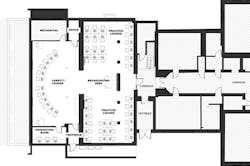Ohio University’s OHIO Esports Arena redefines video gaming
If a college student enjoys film studies, there is probably a place on campus where they can join other film buffs. Similarly, performing arts fans likely have spaces where they can ply their craft with like-minded students.
But where can students who like video games go? This is the question that haunted Ohio University (OHIO) Esports Director Jeff Kuhn.
“There are always spaces, programs, departments, and even colleges devoted to traditional media,” said Kuhn. “And while gaming is second only to online streaming in terms of popularity among college-age students, most colleges and universities don’t have a dedicated space for gamers.”
"What we’re really discussing is the growth of video games as a culture and business that universities need to start recognizing and planning for." Jeff Kuhn, OHIO Esports Director
Kuhn envisioned a space at OHIO that would not only serve as a hub for serious gamers and hobbyists but also become a destination where other university programs could expand via video game technologies.
The resulting renovation, designed by Legat Architects and built by 2K General Company, transforms a basement storage space in Ohio University’s historic Scripps Hall into the OHIO Esports Arena. The 3,200-square-foot center welcomes everyone from students with aspirations of national competitive gaming to instructors with low video gaming literacy.
Kuhn said, “The arena gets students out of their dorm rooms and gives them a place to compete, socialize, and build workplace skills in many industries connected to competitive esports.”
No More Coke and Cheetos: A Cultural Shift in Gaming
A spokesperson at Cumming, which provided cost estimating services for the project, said the perception of video gaming has come a long way since the eighties when kids “played games in their basements or bedrooms while drinking Coke and eating Cheetos. Today, it’s about students getting together for a common interest… not sitting alone.”
Current estimates suggest about 234 million people are involved in esports worldwide. It is one of the fastest-growing sports poised to outpace traditional college sports. Between 2019 and 2021, the esports global market value grew more than 10% from $957.5 million to $1.08 billion.
A growing number of colleges across the U.S. are assembling esports teams. The National Association of Collegiate Esports has more than 170 member institutions representing over 5,000 athletes. Many students are seeking out institutions with the best esports programs.
Kuhn adds that esports encapsulates not just competitive video gaming but also the many jobs and industries that connect to it. He cites the digital wizardry seen in everything from Formula One and Super Bowl broadcasts to Weather Channel updates and Disney TV shows—they all have roots in video game tech.
“What we’re really discussing is the growth of video games as a culture and business that universities need to start recognizing and planning for,” said Kuhn.
He has identified a significant generational divide when it comes to playing video games. At Ohio University, for instance, Kuhn’s research revealed that more than 75% of students play video games whereas only a quarter of staff members do so. The OHIO Esports Arena becomes a means of bridging that gap.
All Are Welcome
When Legat’s Sana Khwaja first saw the dark, clustered storage space that would become the arena, she thought, “This isn’t where you put an esports facility.”
The area was divided into several small rooms, plus a 24-inch-thick masonry wall bisected the space. Most worrisome were the mechanical shortcomings of the 117-year-old building. The space’s saving grace was its high-profile location in Scripps College of Communication, directly across from the student union.
After exploring four different layouts, the team decided on an option that demolishes all interior walls (including the large masonry one). The resulting open space features a 12-athlete (six home, six away) varsity competition space and a practice area with 30 computers. Within the practice area, a lounge area with couches and console games encourages students to gather. A broadcasting island bridges the competition and practice spaces.
"We’ve seen a big uptick in prospective students contacting us to learn more about our teams and arena." – Jeff Kuhn
“We wanted the space to be inclusive and welcome all students, not just gamers,” said Khwaja. “Both the layout and the integration of many types of media achieve that objective.”
Many esports arenas look like something out of a sci-fi movie: mostly dark spaces illuminated by neon lights. Ohio University wanted its arena to take a different direction.
Carli Sekella, project manager at Legat, said, “We didn’t want the arena to feel like a basement, but rather like a bright and open space where everyone feels comfortable.”
A panel in the production room controls seven lighting zones. During competitions, overall lighting in the competition area can be lowered, and it can illuminate the home team in green and visitors in gold.
The renovation also creates a much cleaner entry sequence with two large windows and a glass door that display the space to passersby. A trapezoidal wall identifies the registration area on one side and the broadcasting area on the other.
One of the biggest challenges of the renovation was a complete replacement of outdated HVAC systems to ensure student comfort.
“We’re talking 50 gamers plus people watching plus production plus broadcasting,” said Sekella. “That’s a lot of bodies.”
The makeover also adds a secondary entry/exit in the competition area—limiting means of egress to the existing facility’s sole entry would have reduced the space’s maximum occupancy.
A Nonnegotiable Ceiling
When the time came to consider ways to reduce costs to meet the budget, the one thing the OHIO team insisted on keeping was the wood grille ceiling. The feature creates a central corridor that draws people in and connects the spaces.
“The concept of integration propelled the entire project,” said Khwaja. “Integration of esports with digital technology, integration of athletes/gamers with journalism majors, integration of the practice room with the competition space. The ceiling feature not only physically bridges the two main spaces but also represents the integration of the sport with the rest of the campus and beyond.”
More than Gaming
According to Kuhn, the pandemic intensified students’ desire for a live audience. The arena’s competition space holds an audience of up to 20, but the action can be streamed online as well. A high-stakes tournament might involve closing off the audience space and streaming everything online.
The OHIO Esports Arena is much more than a space for gamers—it is a place where students in other programs can go to benefit from video game technologies. Kuhn gives the example of students doing research on the effects of video games on heartbeat or neuromuscular reactions. A Grandmaster in the “StarCraft” video game series, he said, completes 500 to 600 actions per minute on a mouse and keypad.
The space also offers many journalism student opportunities ranging from reporting on esports stories to broadcasting and production work. The broadcasting zone enables students to create esports-related newscasts and even offer commentary on competitions in real time.
“Our esports space is a learning space where students are actively engaged in work that will benefit them post-graduation,” said Kuhn.
He also plans to use the space to host workshops and training for faculty who may not be familiar with games or who want to take advantage of video games’ teaching abilities—the typical classroom lacks the computing power to handle high-end gaming.
Out of the Dorms and into the Arena
The OHIO Esports Arena had its official opening on September 12, 2022. During the first two weeks, it welcomed 310 users who logged 739 play hours. The average user stayed 3.6 hours per visit and came to the arena two to three times a week.
Additionally, the OHIO Esports team saw a meteoric rise on its social media channels. Profile visits jumped 1,533 percent, and the program achieved 51,300 tweet impressions, 12,000 Instagram views, and 128 hours watched on Twitch.
Kuhn also noticed a “big uptick in prospective students contacting us to learn more about our teams and arena, which are deciding factors for those who’ve narrowed down their choice to a few universities.”
As for the esports athletes, said Kuhn, giving students a place to compete together (instead of being confined to their dorms by COVID) has boosted their performance and spirit. Just watch an excerpt of competition footage on the official Bobcat Esports Twitter account to get a sense of the energy within the OHIO Esports Arena. You’ll see fans and school colors. You’ll see applause, raising of fists, and whooping… just what you’d expect in a sports arena.
Contact us to learn more about esports facilities or comment below to share your thoughts on this post.





